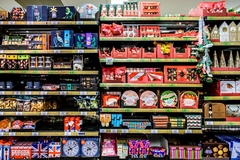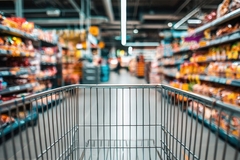
- Industry news
Industry news
- Category news
Category news
- Reports
- Key trends
- Multimedia
- Journal
- Events
- Suppliers
- Home
- Industry news
Industry news
- Category news
Category news
- Reports
- Key trends
- Multimedia
- Events
- Suppliers
UK food price inflation accelerates amid COVID-19

29 Apr 2020 --- British consumers are facing inflated food prices for ambient and fresh products, with the latest retail data revealing these have peaked since last June. Despite rising costs, food prices remain relatively low as a more significant price drop in other sectors was recorded, according to the BRC-Nielsen Shop Price Index for April 2020. The sector is gradually recovering from a significant dip in March sales following the initial COVID-19 outbreak in Europe.
Food inflation accelerated to 1.8 percent in April, up from 1.1 percent in March. This is above the 12- and six-month average price increases of 1.5 percent and 1.5 percent, respectively. This is the highest inflation rate since June 2019.

“Overall, shop prices fell in April, with a larger drop in non-food prices outweighing the rise in food inflation. Food retailers offered fewer promotions this April as they worked to discourage the consumer stockpiling of the previous month, pushing food inflation slightly above average,” says Helen Dickinson, Chief Executive at the BRC.
“In March, the necessary measures to fight the spread of coronavirus led to the worst decline in retail sales on record. Furthermore, the headline figure masked even more dramatic swings. Food and essentials faced an unprecedented surge in demand in the early part of March, only to drop significantly into negative growth after the lockdown and introduction of social distancing in stores,” she details.
In the Fresh Food segment, inflation accelerated to 1.0 percent in April, up from 0.4 percent in March. This is above the 12- and six-month average price increases of 0.9 percent and 0.6 percent, respectively.
Meanwhile, inflation in the Ambient Food category accelerated to 3 percent in April, up from 2 percent in March. This is above the 12- and six-month average price increases of 2.4 percent and 2.6 percent, respectively. This is the highest inflation rate since April 2019.
“Retailers who remain open face rising costs from implementing social distancing measures, protective equipment and rising import prices, yet they continue to deliver value on their products. With the UK facing months of economic uncertainty and the prospect of rising job losses, many customers have cut back on spending,” stresses Dickenson.
“A speedy economic recovery is key to rebuilding consumer confidence, but businesses cannot do it alone. The government has demonstrated great support for the industry and it must be ready to take measures to revive consumer demand after lockdown has lifted,” she concludes.
Earlier this month, UK supermarket chain Tesco announced that British panic buying is “stabilizing” with “more normal” sales volumes being observed in comparison to during the start of the year.
 Amid the volatile market conditions spurred on by the pandemic, the Food and Agriculture Organization (FAO) Food Price Index was pushed down as world food prices dropped in February.Pandemic-related shifts in purchasing behavior
Amid the volatile market conditions spurred on by the pandemic, the Food and Agriculture Organization (FAO) Food Price Index was pushed down as world food prices dropped in February.Pandemic-related shifts in purchasing behavior
The ongoing COVID-19 pandemic has already impacted consumer behavior in the short-term and there are forecasts it will leave a lasting impression in the consumer mindset. While businesses are struggling due to lockdowns, quarantine measures and to some extent, global supply chain fracturing, there are a number of food businesses – particularly in the ambient sector – experiencing a surge in demand.
According to Innova Market Insights, consumers in Germany, the US and the UK shifted their attention to products with a long shelf life when buying food and drinks during the COVID-19 outbreak. In the US and the UK, soup was one of the largest “more purchased” categories, whereas consumers in Germany went for more baking products, bread and chocolate.
In stark contrast, “health aspects” became an important reason to purchase a food or beverage amid COVID-19 for Brazilian, Indian and Chinese consumers. Accordingly, consumers in these countries reported a notable increase in purchasing fresh vegetables, items that many European consumers reported buying less of since the outbreak.
Amid the volatile market conditions spurred on by the pandemic, the Food and Agriculture Organization (FAO) Food Price Index was pushed down as world food prices dropped in February. The Food Price Index averaged 180.5 points in February, down 1 percent from the previous month but still 8.1 percent higher than a year earlier.
For more pandemic-related industry updates, readers may visit our new daily news feed entitled “COVID-19 updates” for relevant insights needed to guide your business through this challenging period.
By Benjamin Ferrer










